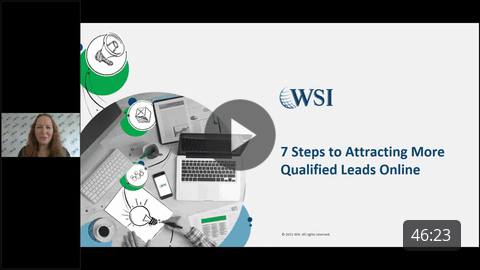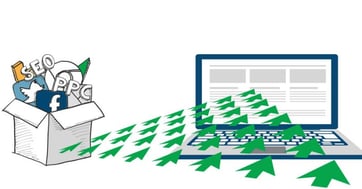For the last 25+ years, WSI has helped 100,000 businesses navigate the complexity of digital marketing. Attracting more qualified leads online is just one of the topics we have covered in webinars intended to educate and share best practices on aspects of digital marketing.
Managing director at an Atlanta-based WSI Agency, Gerardo Kerik draws on his years of experience at Fortune 500 companies where he launched brands and products in the US, Europe, South East Asia, and Latin America.
What is a Lead?
“A lead is an individual or organization interested in what you are selling. The interest is expressed by sharing contact information, like an email ID, phone number, or social media handle.”
Leads vary from cold to warm or hot leads, depending on how engaged they are with your products or services. There are two types of leads: Marketing Qualified Leads (MQL) and Sales Qualified Leads (SQL). MQLs are leads that engage with your marketing activities, e.g., a webinar. SQLs are high-quality leads showing a clear intent and ability to buy.
Ideally, you want to scale up the quantity of quality leads for your business to achieve your goals.
What is Lead Generation?
Lead generation attracts and identifies potential customers (or leads) for a business's products or services. It typically involves strategies and tactics to capture interest through various channels, such as content marketing, social media, paid search advertising, and email marketing. Once potential leads are identified, businesses can engage with them through personalized follow-ups and lead nurturing campaigns to move them through the sales funnel, ultimately converting them into paying customers. Lead generation is crucial for maintaining a steady stream of prospective customers and ensuring ongoing business growth.
The lead generation process is fundamental to attracting qualified prospects and converting them into leads more likely to result in sales.
The 7-Step Framework to Generate Leads Online
1. Set Clear Goals
Using a mathematical formula, you can enter the average sales price of your product and your average lead-close rate to calculate the number of leads you need to achieve your revenue objective. Including the average cost per lead will return your total budget.
If you don’t have these figures for your business, use industry averages in the meantime.
Example Formula and Calculation:
Leads = Revenue Goal / (Average Sales Price × Conversion Rate)
If your revenue goal is $500,000, your average sales price is $2,500, and your conversion rate is 10%, the calculation would be:
Leads = 500,000 / (2,500 × 0.10) = 200 Leads
2. Develop Accurate Buyer Personas
“A buyer persona is a semi-fictional representation of your ideal customer based on market research and real data about your existing customers.”
To find out the interests, pains, and challenges of your ideal customers, consider interviewing customers, studying your contact database, leveraging website forms, and getting feedback from your sales team. Then, brainstorm with your sales and marketing teams to create buyer personas from the info you have gathered. (Get our eBook, How to Create Buyer Personas, from your friendly WSI Consultant.)
Contact Your Local WSI Consultant
3. Mapping the Buyer's Journey
Map the process buyers go through to:
- Become aware of a need.
- Consider options to solve the need.
- Decide to make a purchase.
Be sure to match journey touchpoints to your type of business (B2B vs B2C).
4. Content Mapping and Offers
An effective strategy to maintain engagement with your business delivers the right type of content to each buyer persona at the right time.
Generate qualified leads with an offer that will motivate your prospects to share their contact information in exchange for it, i.e., a lead magnet.
Your local WSI Consultant can assist you with a content audit.
5. Move a Lead Through the Conversion Path
What digital path is followed to convert an anonymous website visitor to a lead to a buyer? The four essential elements include a download offer landing page, a conversion form, and a thank you page, and in return, you get an email address lead.
6. Choosing the Right Marketing Channels
This step can only be addressed as a consequence of the previous steps. Now, you determine what marketing tactics will achieve your revenue goals.
Each channel (paid or organic search, social, display, email) has its own benefits and is mapped to steps on the buyer’s journey.
7. Leveraging Reporting to Increase Lead Quality
For one-on-one help with your online lead generation strategy or any other aspect of digital marketing, contact WSI without delay! Whether you're looking to improve your lead qualification process, fine-tune your sales process, or explore new marketing channels, we have the expertise to help you succeed.
Or catch up with our full webinar recording on generating more qualified leads below:






